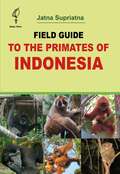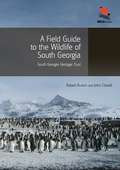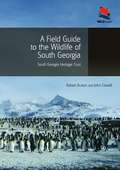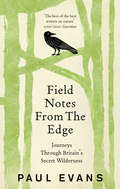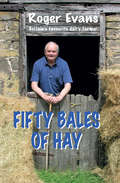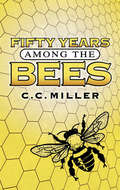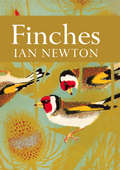- Table View
- List View
Field Guide to the Primates of Indonesia
by Jatna SupriatnaThis primate field guide can be used to refer to information on each species, or it can be used to find which species exist on each island, as shown at the back of the book. A list of primates in Indonesia is provided with local, English, and scientific names. Once the name is identified the user can go to the description of the genus and species. Also given is the conservation status of each species except for the most recently described, whose status is not yet known. The information on each species' natural history, behavior, ecology, and where to see it in parks and/or forested areas outside parks is included. Field Guide to the Primates of Indonesia primate drawings are by Stephen Nash and photographs were donated by many of the author's friends from Indonesia and abroad.
A Field Guide To The Reptiles Of South-East Asia
by Indraneil DasSouth-East Asia is home to one of the most diverse reptile faunas on Earth. A Field Guide to the Reptiles of South-East Asia is the first comprehensive guide to the snakes, lizards, crocodiles, tortoises and turtles of the region.Covering more than 1000 species and subspecies in thorough detail, this field guide provides authoritative, up-to-date information on identification, habitat, behaviour, subspecies, distribution and status. The informative text explains the behaviour and morphology of reptiles, as well as how to measure and identify species according to scale counts and other anatomical features.South-East Asia is one of the most important ecotourism destinations in the world, with an expanding local market as wildlife conservation assumes greater prominence locally. This guide is essential reading for anyone interested in the wildlife of the region - wildlife enthusiasts, students, conservation planners and specialists alike.
A Field Guide To The Reptiles Of South-East Asia
by Indraneil DasSouth-East Asia is home to one of the most diverse reptile faunas on Earth. A Field Guide to the Reptiles of South-East Asia is the first comprehensive guide to the snakes, lizards, crocodiles, tortoises and turtles of the region.Covering more than 1000 species and subspecies in thorough detail, this field guide provides authoritative, up-to-date information on identification, habitat, behaviour, subspecies, distribution and status. The informative text explains the behaviour and morphology of reptiles, as well as how to measure and identify species according to scale counts and other anatomical features.South-East Asia is one of the most important ecotourism destinations in the world, with an expanding local market as wildlife conservation assumes greater prominence locally. This guide is essential reading for anyone interested in the wildlife of the region - wildlife enthusiasts, students, conservation planners and specialists alike.
A Field Guide to the Reptiles of Thailand
by Tanya Chan-ard Jarujin Nabhitabhata John W. ParrThailand is home to over 350 species of reptiles, consisting of many kinds of turtles and tortoises, lizards, snakes and crocodiles. With its extensive network of protected areas, Thailand is one of the richest and most ecologically diverse countries in the world. However, many of these species are being threatened more than ever before, including habitat loss caused by agricultural expansion and intensification, and from wildlife trade. For herpetologists and naturalists, understanding the reptiles of Thailand is now more important than ever before. With A Field Guide to the Reptiles of Thailand, Tanya Chan-ard, John Parr, and Jarujin Nabhitabhata present the definitive resource for identifying and understanding all known species of reptile in the region. It is the only updated and complete guide to the country's reptilian life in existence. The book contains an account of every species, complete with nomenclature, color illustrations, and range maps of known locations. The accounts include discussion of behavior, morphological measurements, and habitat, as well as the most current information on each species' conservation status. The authors explain the current system of classifying the threat level of endangerment, making the presented information and terminology understandable and useful. The introduction to the book discusses the history of herpetology in Thailand, as well as its climate, physiography, and zoogeography. A section on how to use the guide most effectively has also been included to make the book accessible to a wide range of both scientists and nature enthusiasts. A Field Guide to the Reptiles of Thailand is the definitive and most comprehensive resource for herpetologists, naturalists, and conservationists working in Thailand.
A Field Guide to the Reptiles of Thailand
by Tanya Chan-ard Jarujin Nabhitabhata John W. ParrThailand is home to over 350 species of reptiles, consisting of many kinds of turtles and tortoises, lizards, snakes and crocodiles. With its extensive network of protected areas, Thailand is one of the richest and most ecologically diverse countries in the world. However, many of these species are being threatened more than ever before, including habitat loss caused by agricultural expansion and intensification, and from wildlife trade. For herpetologists and naturalists, understanding the reptiles of Thailand is now more important than ever before. With A Field Guide to the Reptiles of Thailand, Tanya Chan-ard, John Parr, and Jarujin Nabhitabhata present the definitive resource for identifying and understanding all known species of reptile in the region. It is the only updated and complete guide to the country's reptilian life in existence. The book contains an account of every species, complete with nomenclature, color illustrations, and range maps of known locations. The accounts include discussion of behavior, morphological measurements, and habitat, as well as the most current information on each species' conservation status. The authors explain the current system of classifying the threat level of endangerment, making the presented information and terminology understandable and useful. The introduction to the book discusses the history of herpetology in Thailand, as well as its climate, physiography, and zoogeography. A section on how to use the guide most effectively has also been included to make the book accessible to a wide range of both scientists and nature enthusiasts. A Field Guide to the Reptiles of Thailand is the definitive and most comprehensive resource for herpetologists, naturalists, and conservationists working in Thailand.
A Field Guide to the Tiger Beetles of the United States and Canada: Identification, Natural History, and Distribution of the Cicindelinae
by David L. Pearson C. Barry Knisley Daniel P. Duran Charles J. KazilekMore than 2600 species of tiger beetles are found all over the world. In North America there are 116 species of tiger beetle, divided into 153 geographically distinct races. Detailed studies of their natural history, population dynamics, communities, patterns of worldwide species richness, and taxonomy of particular subgroups have produced much information. Tiger beetles are among the most widely investigated groups of insects, especially in terms of their ecology and geographic distribution. The first edition of A Field Guide to the Tiger Beetles of the United States and Canada, published in 2005, has served as a field and natural-history guide to all known species of tiger beetles found in North America above the Mexican border. The 2nd edition is a pleasant and comprehensible handbook of the identification, distribution, natural history, and habitat details of the 116 species of tiger beetles in North America. The updated handbook provides new information including observations of seasonality, range extensions and biology, a newly developed list of common names, and twenty-five artistically pleasing identification color plates. The second edition of A Field Guide to the Tiger Beetles of the United States and Canada provides essential information to recognize and easily identify tiger beetles for established naturalists and outdoor enthusiasts alike.
A Field Guide to the Tiger Beetles of the United States and Canada: Identification, Natural History, and Distribution of the Cicindelinae
by David L. Pearson C. Barry Knisley Daniel P. Duran Charles J. KazilekMore than 2600 species of tiger beetles are found all over the world. In North America there are 116 species of tiger beetle, divided into 153 geographically distinct races. Detailed studies of their natural history, population dynamics, communities, patterns of worldwide species richness, and taxonomy of particular subgroups have produced much information. Tiger beetles are among the most widely investigated groups of insects, especially in terms of their ecology and geographic distribution. The first edition of A Field Guide to the Tiger Beetles of the United States and Canada, published in 2005, has served as a field and natural-history guide to all known species of tiger beetles found in North America above the Mexican border. The 2nd edition is a pleasant and comprehensible handbook of the identification, distribution, natural history, and habitat details of the 116 species of tiger beetles in North America. The updated handbook provides new information including observations of seasonality, range extensions and biology, a newly developed list of common names, and twenty-five artistically pleasing identification color plates. The second edition of A Field Guide to the Tiger Beetles of the United States and Canada provides essential information to recognize and easily identify tiger beetles for established naturalists and outdoor enthusiasts alike.
Field Guide to the Wildlife of New Zealand
by Julian FitterNew Zealand's dramatic scenery is home to some equally dramatic wildlife, featuring a host of endemics found nowhere else in the world. From giant wetas and the ancient Tuatara to a suite of beautiful birds, including flightless wonders such as the Kiwi and Kakapo, these animals help make New Zealand one of the world's greatest wildlife-tourism destinations. Although there have been severe losses due to introduced predators, the country has a fiercely determined conservation sector, and the future looks bright.This fully revised and updated second edition of Julian Fitter's classic photographic field guide illustrates most of the vertebrate species to be found on the islands, there, as well as a large number of typical invertebrates and flora, with the photography accompanied by concise species texts. Reader-friendly and portable yet covering everything the visitor is likely to see, this book is an invaluable companion for anyone visiting these biodiverse Pacific islands.
Field Guide to the Wildlife of New Zealand
by Julian FitterNew Zealand's dramatic scenery is home to some equally dramatic wildlife, featuring a host of endemics found nowhere else in the world. From giant wetas and the ancient Tuatara to a suite of beautiful birds, including flightless wonders such as the Kiwi and Kakapo, these animals help make New Zealand one of the world's greatest wildlife-tourism destinations. Although there have been severe losses due to introduced predators, the country has a fiercely determined conservation sector, and the future looks bright.This fully revised and updated second edition of Julian Fitter's classic photographic field guide illustrates most of the vertebrate species to be found on the islands, there, as well as a large number of typical invertebrates and flora, with the photography accompanied by concise species texts. Reader-friendly and portable yet covering everything the visitor is likely to see, this book is an invaluable companion for anyone visiting these biodiverse Pacific islands.
A Field Guide to the Wildlife of South Georgia (WILDGuides #107)
by Robert Burton John CroxallSouth Georgia is rich in wildlife and spectacular scenery, and it is a prime destination spot on most Antarctic tours. This beautifully illustrated field guide depicts the birds, mammals, insects, flowering plants, and other vegetation found in this unique part of the world. It features 368 full-color photographs of more than 180 species, including 65 species of birds, 20 species of sea mammals, nearly 60 species of insects, and more than 40 species of flowering and nonflowering plants. Detailed species accounts describe key identification features, with information on status, behavior, threats, and distribution. This one-of-a-kind photographic guide also includes introductory chapters on South Georgia's geography, climate, ecology, and conservation.Features 368 photos of more than 180 species Covers birds, sea mammals, insects, and plants Provides detailed species accounts Includes chapters on geography, climate, ecology, and conservation The only photographic field guide to focus specifically on South Georgia
A Field Guide to the Wildlife of South Georgia (PDF)
by Robert Burton John CroxallSouth Georgia is rich in wildlife and spectacular scenery, and it is a prime destination spot on most Antarctic tours. This beautifully illustrated field guide depicts the birds, mammals, insects, flowering plants, and other vegetation found in this unique part of the world. It features 368 full-color photographs of more than 180 species, including 65 species of birds, 20 species of sea mammals, nearly 60 species of insects, and more than 40 species of flowering and nonflowering plants. Detailed species accounts describe key identification features, with information on status, behavior, threats, and distribution. This one-of-a-kind photographic guide also includes introductory chapters on South Georgia's geography, climate, ecology, and conservation.Features 368 photos of more than 180 species Covers birds, sea mammals, insects, and plants Provides detailed species accounts Includes chapters on geography, climate, ecology, and conservation The only photographic field guide to focus specifically on South Georgia
Field Guide to Whales, Dolphins and Porpoises
by Mark CarwardinePractical and portable, this is the ultimate field guide to the world's cetaceans.This outstanding new field guide to whales, dolphins and porpoises is the most comprehensive, authoritative and up-to-date guide to these popular mammals. With more than 500 accurate and detailed illustrations – complete with detailed annotations pointing out the most significant field marks – this new field guide covers all 93 species and every subspecies in the world.Many of the world's most respected whale biologists have collaborated on the concise text, which is packed with helpful identification tips from cetacean expert, Mark Carwardine. Mark's informative text is accompanied by up-to-date distribution maps for each species. Beautifully designed, to ensure critical information is quickly accessible, this is an indispensable resource that every whale-watcher will want to carry out to sea.
Field Guide to Whales, Dolphins and Porpoises
by Mark CarwardinePractical and portable, this is the ultimate field guide to the world's cetaceans.This outstanding new field guide to whales, dolphins and porpoises is the most comprehensive, authoritative and up-to-date guide to these popular mammals. With more than 500 accurate and detailed illustrations – complete with detailed annotations pointing out the most significant field marks – this new field guide covers all 93 species and every subspecies in the world.Many of the world's most respected whale biologists have collaborated on the concise text, which is packed with helpful identification tips from cetacean expert, Mark Carwardine. Mark's informative text is accompanied by up-to-date distribution maps for each species. Beautifully designed, to ensure critical information is quickly accessible, this is an indispensable resource that every whale-watcher will want to carry out to sea.
Field Manual for Small Animal Medicine
by Katherine Polak Ann Therese KommedalField Manual for Small Animal Medicine offers anyone working in resource-limited environments a practical resource for delivering veterinary care outside the traditional hospital or clinic setting. Offers the only comprehensive resource for best practices when practicing veterinary medicine in resource-limited environments Integrates practical and cost-effective protocols where the ideal solution may not be available Presents information on vital topics such as operating a field spay/neuter clinic, emergency sheltering, sanitation and surgical asepsis, preventive care practices, zoonotic diseases, and euthanasia Serves as a quick reference guide for common surgical procedures, cytology interpretation, anesthesia and treatment protocols, and drug dosing
Field Manual for Small Animal Medicine
by Katherine Polak Ann Therese KommedalField Manual for Small Animal Medicine offers anyone working in resource-limited environments a practical resource for delivering veterinary care outside the traditional hospital or clinic setting. Offers the only comprehensive resource for best practices when practicing veterinary medicine in resource-limited environments Integrates practical and cost-effective protocols where the ideal solution may not be available Presents information on vital topics such as operating a field spay/neuter clinic, emergency sheltering, sanitation and surgical asepsis, preventive care practices, zoonotic diseases, and euthanasia Serves as a quick reference guide for common surgical procedures, cytology interpretation, anesthesia and treatment protocols, and drug dosing
Field Manual of Techniques in Invertebrate Pathology: Application and Evaluation of Pathogens for Control of Insects and other Invertebrate Pests
by Lawrence A. Lacey Harry K. KayaThis field manual is designed to provide background and instruction on a broad spectrum of techniques and their use in the evaluation of entomopathogens in the field. The second edition provides updated information and includes two additional chapters and 12 new contributors. The intended audience includes researchers, graduate students, practitioners of integrated pest management (IPM), regulators and those conducting environmental impact studies of entomopathogens.
Field Manual of Techniques in Invertebrate Pathology: Application and Evaluation of Pathogens for Control of Insects and Other Invertebrate Pests
by Lawrence A. Lacey Harry K. KayaThe 38 chapters of this Field Manual provide the tools required for planning experiments with entomopathogens and their implementation in the field. Basic tools include chapters on the theory and practice of microbial control agents, statistical design of experiments, equipment and application strategies. The major pathogen groups are covered in individual chapters (virus, bacteria, protozoa, fungi, nematodes). Subsequent chapters deal with the impact of naturally occurring and introduced exotic pathogens and inundative application of microbial control agents. The largest section of the Manual is composed of 21 chapters on the application and evaluation of entomopathogens in a wide range of agricultural, forest, domestic and aquatic habitats. Mites and slugs broaden the scope of the book. Supplementary techniques and media for follow-up laboratory studies are described. Three final chapters cover the evaluation of Bt transgenic plants, resistance to insect pathogens and strategies to manage it, and guidelines for evaluating the effects of MCAs on nontarget organisms. Readership: Researchers, graduate students, practitioners of integrated pest management, regulators, those doing environmental impact studies. The book is a stand-alone reference, but is also complementary to the laboratory-oriented Manual of Techniques in Insect Pathology and similar comprehensive texts.
Field Notes from the Edge
by Paul Evans‘A profoundly satisfying read’ Financial TimesIn Field Notes from the Edge, the acclaimed writer of the Guardian's 'Country Diary', Paul Evans, takes us on a journey through the in-between spaces of Nature – such as strandlines, mudflats, cliff tops and caves – where one wilderness is on the verge of becoming another and all things are possible. Here, Evans searches out wildlife and plants to reveal a Nature that is inspiring yet intimidating; miraculous yet mundane; part sacred space, part wasteland. It is here that we tread the edge between a fear of Nature’s dangers and a love of Nature’s beauty.Combining a naturalist’s eye for observation with a poet’s ear for the lyrical, Field Notes from the Edge confirms Paul Evans's place among our leading nature writers today.
Fifty Bales of Hay: Britain's Favourite Dairy Farmer
by Roger Evans"Roger Evans faces each day on his dairy farm in Shropshire with a wonderful mixture of dry humour, sharp observation and a delight in the natural world and the animals around him. This latest book of his popular diary entries takes his fans through the weeks of the past two years and covers his beloved farm dogs, his cattle, his friends at the pub. He struggles through all weather, survives the ups and (mainly) downs facing everyone in the dairy industry and he encounters several unexpected events along the way. Very funny, uplifting and a joy to read. "
Fifty Years Among the Bees: Complete Book Of Bee Keeping
by C. C. MillerOne of the few people of his time who actually made a living from bees, C. C. Miller made beekeeping his sole business, beginning as a hobby in 1861 and continuing until his death in 1920, following a long and distinguished career that produced many articles and books on the subject. This volume, long a classic within the beekeeping community, is a practical, yet endlessly charming handbook on all aspects of a romantic and arcane pursuit. Offering advice, observations, and information gleaned from more than a half-century of beekeeping, it covers, among many other topics, the importance of keeping hives clean and well-ventilated, mending combs, maintaining proper hive temperatures, winter storage, the Queen's nursery, harvesting honey, plus a special section of recipes that range from honey cake to salves for frostbite. Written by a major figure in apiculture history, this volume remains a standard text on hive management and the practices and principles of efficient, effective beekeeping.
The Filaria (World Class Parasites #5)
by Thomas R. Klei T. V. RajanFilarial nematodes constitute and important group of human pathogens in tropical regions of the world. Diseases associated with these worms are generally separated into two categories: filariasis, caused by infections of lymphatic dwelling parasites and onchocerciasis, or river blindness, caused by infections of Onchocerca volvulus. Other filariae specifically infect humans and it is likely that zoonotic filarial infections may alter the outcome of infections with human parasites. The chapters in this book will cover concepts that, in most instances, overlap all of these parasites as well as focus on new and emerging ideas. The Filaria, volume five of World Class Parasites, is written for researchers, students and scholars who enjoy reading research that has a major impact on human health, or agricultural productivity, and against which we have no satisfactory defense. It is intended to supplement more formal texts that cover taxonomy, life cycles, morphology, vector distribution, symptoms and treatment. It integrates vector, pathogen and host biology and celebrates the diversity of approach that comprises modern parasitological research.
Finches (Collins New Naturalist Library #55)
by Ian NewtonThis illustrated survey of finch behaviour is a thorough, non-technical account of the habits of these birds throughout the world.
Finches and Sparrows: An Identification Guide (Helm Identification Guides)
by Peter ClementThis is a guide to true" finches and sparrows illustrating all thespecies, many races and most sex and age variations, with almost 950portraits. The maps accompanying the illustrations show breeding andwintering ranges for all species. Although the guide is not primarilyintended for cagebird enthusiasts, it will also be useful for thosewishing to know more about the species encountered in captivity."
Finches and Sparrows (Helm Identification Guides)
by Peter Clement Alan Harris John DavisThis is a guide to true" finches and sparrows illustrating all thespecies, many races and most sex and age variations, with almost 950portraits. The maps accompanying the illustrations show breeding andwintering ranges for all species. Although the guide is not primarilyintended for cagebird enthusiasts, it will also be useful for thosewishing to know more about the species encountered in captivity."
Finches For Dummies
by Nikki MoustakiExplore the wide world of finches Finches For Dummies is your entry into the fascinating world of finches. Canaries are probably the most well-known type of finch, but finches are a widely diverse species of birds. They actually encompass several hundred different types of birds, including Gouldians, goldfinches, zebra finches, and owl finches. They also come in an amazing variety of shapes, colors, and sizes. Some are very vocal; some are not. How you care for your finch depends on its species, size, and temperament. But no need to stress. Finches For Dummies is here to help you find the perfect feathered friend! This practical guide sets you up to become a responsible finch caretaker. Inside, you’ll find information on: Feeding your finches and keeping them healthy Choosing the ideal enclosure and supplies for your finches Adjusting to finch life with children or other pets Breeding your finches With the advice and tips in Finches For Dummies, you and your pet finches can maintain a fun and thriving relationship for a long time. If you’re interested in adopting one of these amazing birds, pick up a copy!
